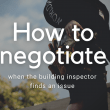Are you contemplating selling your plaster home? In this article, I outline the seven key steps you need to take to maximise your chances of achieving a successful sale.
Disclaimer: I am not a builder. Please, please, please speak to your solicitor, building inspector and other professional advisers as necessary before buying or selling a plaster home. This information is based on my experience working in NZ as a real estate agent, business owner and coach since 2007.
Take a moment to let these words sink in…
Every single property on the market would sell tomorrow if price didn’t matter.
Read them again and memorise them. In the words of the great Ozzy Osbourne, “there are no un-singable songs” and in the words of this real estate agent, there are no un-sellable homes.
Every home has a price, even a plaster one. Would you like to maximise it? Read on to find out how.
A bit of background…
The leaky-home saga (traditionally associated with, but not limited to, plaster homes built between 1994 – 2004 approx.) has caused more anguish and heartbreak than any other property related issue in our Country’s history.
I can’t begin to imagine what it must have been like to purchase your dream home, thinking it was well built because it had a Council Code Compliance Certificate, only to find out a few years later that your biggest asset is full of moisture and you are looking at a bill for hundred’s of thousand’s of dollars to repair or reclad.
So many unfortunate home-owners have been caught out by leaky homes over the years and I feel for every single one of them.
Buyers are now becoming more aware of the risks that come with monolithic/texture-coated cladding (and the need to obtain a builder’s report from a reputable inspector). So thankfully fewer purchasers are being caught out.
What to do with all those plaster homes then?
Many (if not most) of the houses built in this era are still performing perfectly fine as family homes and rental properties.
Most plaster homes have stood the test of time now (20+ years) without issue. With the right maintenance plan, they will last for some years to come. And in the words of SPPI:
“If you want a nice house, in a certain area, on a fixed budget, monolithic cladding may be your only option.”
In other words, plaster homes in good condition are generally a lot cheaper than their weatherboard counterparts. Buyers will take on some risk to be able to afford an area/suburb they might have otherwise been priced out of.
How sellable is a plaster home?
Properties with a plaster exterior are harder to sell, no two ways about it. Every salesperson becomes a little bit less excited about a potential listing once they realise it’s a plaster home. You have to have patience, persistence and a proven process to get the desired result.
When selling a plaster home there are 7 key steps you need to follow to ensure you have the best chance of achieving a successful sale in a reasonable amount of time (with minimal heartache).
Step 1. Wash and Paint the property
Every home requires maintenance. Plaster homes require more than others. You can leave a weatherboard home for 20-30 years without painting it and she’ll still be ok. Plaster homes need to be painted at least every 7-10 years, with regular ‘check-ups’ in-between and a regular soft house wash every 12 months.
One of the issues with monolithic cladding is that it isn’t flexible. All houses move and settle over time, and when they do, cracks can appear in a plaster exterior. This is where water often gets in. Once it’s in, moisture gets trapped inside and over time the timber framing can start to deteriorate as a result.
To counter this, a number of companies have now created special paint coatings specifically made for plaster homes which have built-in elasticity. So even if your property moves, cracks shouldn’t appear. The paint/coating literally stretches as required to keep your exterior waterproof.
If you own a plaster home, get your property painted with one of these special coatings and provide prospective buyers with a certificate to show you have had the work done. It will cost you more than a normal, standard paint job but it will be well worth the extra expense. For more info, visit the sites below:
Note: I am not personally endorsing either of these companies and have not used them personally. They are included here to show you examples of businesses who specialise in helping owners of plaster homes. You can find more by searching online. You could also ask your local building inspector for recommendations.
Step 2. Get a builder’s report
There is no point investing in a marketing campaign, dealing with nosey buyers poking around your home, taking on the stress of selling, only to find out there is an issue with the property once a prospective buyer shows their builder through. By then it’s normally too late to do anything about it since any issue with a plaster home will probably put a buyer off.
Get a report done before you go on the market so you know whether there are hidden issues you need to deal with first.
Note: There are some solicitors who don’t believe you should provide a builder’s report to prospective purchasers when selling your home so always talk to your solicitor first. I can say though, that in my experience, providing a builder’s report up front gives buyers confidence and will make your property easier to sell.
Check out: How to read a builder’s report
Make sure the report is completed by a reputable inspection company that is well known in your marketplace. It should be detailed but fair, include large numbers of images, moisture readings and constructive advice where issues are found. Ask to see an example report before you hire an inspector. You may consider going further and obtaining a thermal imaging report for extra clarity/peace of mind.
Key risk factors a builder will look for:
- Decks attached directly to the plaster cladding.
- Lack of ground clearance (distance between the bottom of the cladding and the ground).
- No over-hanging roof (one that extends out past the cladding).
- Internal guttering.
- ‘Interior’ decking positioned over a room or garage, often with Butynol membrane flooring.
- Recessed windows.
The fewer ‘risk factors’ your property has, the easier it will be to achieve a reasonable sale price.
Step 3. Provide a LIM report
There is only one provider (your local Council) and it’s the same whether you get the LIM or the buyer does, so why not make it easy on your prospective purchaser. Save them the money and get the LIM report up front. Take one hurdle out of the process to increase your chances of success.
Note: When owners find out they have a home with weather-tightness issues, a claim is sometimes filed with the Weathertight Homes Tribunal. Once this occurs, that claim shows up on the LIM report and must be disclosed to all potential Purchasers. The property is then effectively labelled as a ‘leaky home’.
Once it’s on the LIM, that record can never be removed, no matter how much remedial work is undertaken. Sadly, the negative effect this label has on the property’s value is often worth far more than the amount awarded by the tribunal.
Check out: How to read a LIM report
Step 4. Explore any issues highlighted and make necessary repairs
Did your builder find a high moisture reading in your downstairs bedroom? It’s time to investigate and get it fixed. Consult a builder who has experience working with plaster homes. Ask friends (or Facebook) for recommendations or consult a site like builderscrack.co.nz.
Sometimes moisture meters can give false readings. During your investigations, you may end up putting holes in walls only to find completely dry framing behind. Don’t be upset by this. Take lots of photos, repair the hole and show buyers that you have been thorough in your efforts to uncover any issues.
Consult with your building inspector and ask them to update their report following your investigation. They probably won’t remove the initial finding but they should be prepared to add a note regarding the results of your investigation or re-check the area.
Step 5. Hire an experienced salesperson
This is so critical. I would only hire a salesperson who has sold plaster homes previously. Ask them to show you case studies of properties similar to yours. How long did they take to sell? What challenges did they encounter?
You certainly don’t want to go with the cheapest option here. Your property already has a certain ‘stigma’ by being plaster-clad. Don’t add to that by listing with an in-experienced or amateur agent who lets it sit on the market for 6 months. You need a pro.
Read: How to Choose an agent to sell your home.
At the same time, you don’t want to hire anyone who is overly negative or who tries hard to talk you down on price before you even get started. They should be cautiously optimistic about achieving a sale if the right marketing plan is put into place.
Step 6. Be realistic on price
Try to ascertain what similar sized properties with weatherboard cladding have been selling for. Now deduct 10-15% off that number. If you have a well-maintained plaster home with eaves, ground clearance and no moisture issues then this is probably a rough guide as to what your property might be worth.
Buyers will expect a discount when a property has a plaster exterior, and/or it is built between 1994 – 2004. This is to be expected. They are taking on some degree of risk and the price should be reduced to reflect this.
If your home isn’t in perfect condition, or if you have 1 or 2 high moisture readings, you may need to deduct anywhere from 20 – 50% off the value of a similar weatherboard home, depending on the extent of the work required.
Read: How to work out the value of any property
Step 7. Sell via Auction or Tender and market the property like your life depends on it.
Empty property? Employ a staging company. Hire the best professional photographer in town. Put a spotlight on your home with a super-feature listing on trademe. Leave no stone unturned. Treat it like a first date: Don’t have 9/10 looks? Then you better turn up wearing your best suit, with a fresh haircut and your biggest smile on display.
Read: 13 cheap and un-common ways to add value to your home
Note: If your home has a cavity system, this will be a major selling point. Make sure this feature is prominently mentioned in all your advertising.
I suggest selling via Auction or Tender so that any potential buyers have plenty of time to complete their due diligence. You don’t want to have a buyer come through for their first look on a Friday night, make an offer you accept, then wake up on Monday and change their mind. An offer that crashes will taint your property throughout the marketing campaign. It’s not worth the risk trying to sell it to someone who hasn’t had time to think it over.
You want them to speak to their advisers (including family), consult with professionals and do all their homework. That way they can make an informed decision about buying your home.
Here’s another reason…
It’s hard to put a value on plaster homes, as it depends on so many factors. Having a few weeks of marketing before you consider any offers is helpful. Your salesperson should be providing buyer feedback throughout the process so you can get a feel for what the market thinks your property is worth.
Hopefully, you get a few offers to consider come Tender day (or a few bidders at Auction). It’s always easier to feel better about accepting an offer or setting a realistic reserve if your property has been exposed to the market for 3-4 weeks.
That way you can feel confident that every potential buyer has had the opportunity to get involved.
Selling a plaster home is possible, especially with the right process and the right salesperson working for you.
Still have questions?
Would you like advice that is specific to your situation? Book a one-on-one phone consultation for $89.











what if you have bought a home like this that the owners wont tell you if the eqc works have been done or not and its unconditional now so dont know where you stand and cant get out of it. The agent event sorted the insurance for us but it was advertised as all the eqc works being completed.
what if you have bought a home like this that the owners wont tell you if the eqc works have been done or not and its unconditional now so dont know where you stand and cant get out of it. The agent event sorted the insurance for us but it was advertised as all the eqc works being completed.
HI Andrew
Where are you based? I’m on the shore between Albany and Coatsville. Our house is stucco, wide waves all way around, dry everywhere and ‘stretchy paint’ all over!
Which agent would you suggest? It’s a lifestyle property with large pool, court and pond. Beautiful grounds.
Hi Paula
Did you find an agent to sell your stucco property?